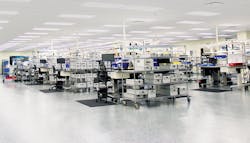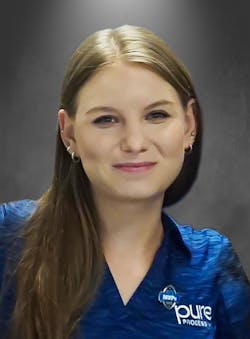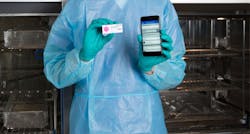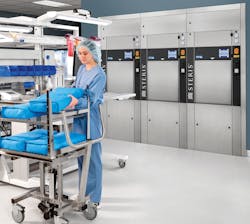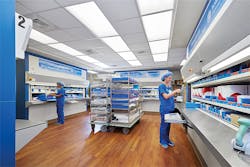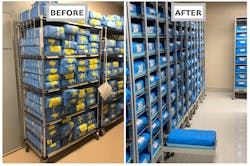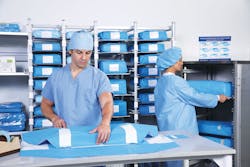As surgical procedures, instruments and devices continue to advance, Central Sterile/Sterile Processing Department (CS/SPD) processes and equipment must evolve as well. Yesterday’s decontamination, cleaning and sterilization practices simply can’t accommodate the complexity and volume of today’s surgical and medical services.
Whether building a new CS/SPD or renovating an existing space, hospitals have access to a broad range of innovations to maximize output, optimize performance, streamline workflow and ensure high-quality reprocessing services.
Investing in IFUs
“More than ever the operating room (OR) demands a quicker turnaround time for surgical instruments, which as a result requires SPD teams to be as productive and efficient as possible,” said Olivera. “Today, most (CS/SPD) departments function using obsolete equipment, processes and facility designs that make it very difficult to perform the simplest tasks. The benefits of applying new technology can be rewarding - improving productivity and process quality - and ultimately keep patients and staff safe and healthy.”
Olivera points to the following innovations as being the “highest need” in the CS/SPD today:
- Online instructions for use (IFU) databases
- Ergonomic equipment
- High-capacity reprocessing equipment
- Cleaning verification and performance qualification technology based on the device manufacturers’ IFU
- Water filtration systems
- Process traceability technology
“Following the reprocessing equipment IFU helps the department maximize the loads and optimize cycles to increase turnaround time,” Olivera added. “Understanding the process listed on the cleaning verification products ensures the technician identifies bioburden left on the instruments and therefore delivers a high-quality product. Being able to find updated instructions for cleaning, disinfecting and sterilizing for a medical device quickly streamlines the process and potentially prevents patient harm.”
Olivera notes how oneSOURCE saves time and streamlines workflow in the CS/SPD. In addition, it allows teams to maintain compliance 24/7 and arms them with the most updated IFU and preventative maintenance (PM) service manuals needed to accomplish the increasingly difficult objectives these departments face.
Smart reprocessing
Most CS/SPD professionals are challenged with limited resources – equipment and staff – coupled with increased pressure from the OR and other clinical customers to reprocess instruments quickly and safely. CS/SPD leaders are always on the lookout for ways to improve efficiency and safety while reducing waste. One way to do so is to avoid unnecessary reprocessing through an automated system that tracks when specific instruments have been processed.
“In less than three days your facility can implement CycleTrak, comply and confidently monitor individual instrument reprocessing cycles,” said Super. “You will be clearly prompted when it is time to retire an instrument from use, manage inventory and reprocessing cycle counts, and generate reports for audit compliance. This helps minimize unnecessary reprocessing, saving CS/SPD time and money.”
Diane Amaral, BSN RN CNOR, Operations Manager, OR, Robotic Coordinator, Hoag Hospital, shares her experience using CycleTrak and the benefits her organization has derived from the solution.
“CycleTrak has saved us money and time, the two most important commodities in the OR world,” said Amaral. “We can immediately check to see if our instruments need to be reprocessed or discarded so we don’t waste time reprocessing instruments with no lives left. This has eliminated the insertion of an instrument during a procedure and discovering that it needs to be replaced, increasing surgeon and staff satisfaction.”
Enhanced visualization
As instrument and device complexity has grown, so has the challenge of cleaning them. For example, cannulated instruments can harbor debris invisible to the naked eye. That is why CS/SPD are increasingly implementing enhanced visualization methodologies to improve reprocessing efficacy, efficiency and safety.
Ash Crowe, MHA, Project Manager, St. Onge Company, points out how the Association for the Advancement of Medical Instrumentation (AAMI) cites the importance of enhanced visualization in its ANSI/AAMI ST79: 2017 Comprehensive guide to steam sterilization and sterility assurance in health care facilities, which states:
“Methods that are able to measure or detect organic residues that are not detectable using visual inspection should be considered in facility cleaning policy and procedures (AAMI7.6.4.5).”
“The enhanced visualization provided by borescopes streamlines the workflow by eliminating rework and helps ensure that instruments are completely cleaned to a department’s high-quality standards,” said Crowe. “They can also be deployed in the clean work area for an additional inspection. From a design perspective, one of the things that’s nice about the borescopes is that they are relativity small and can be added to newly constructed or renovated spaces easily. Often it is even possible to add them to an existing department without any renovation.”
Jeno Lewis, ORT, CRCST, CHL, Central Processing Department Operations Manager, Children’s Hospital of Philadelphia, comments on the use of boroscopes and enhanced visualization when reprocessing reusable devices.
“I wholeheartedly feel borescopes are essential to reprocessing reusable surgical devices, which include any type of inner channel requiring visual inspection,” said Lewis. “It’s being called out in some of the newer and better written IFU manuals that accompany the device specifying the utilization of ‘enhanced visualization.’ I absolutely stand by their effectiveness to provide the opportunity to properly perform internal visual inspections, as well as next-level visualization in areas never inspected previously.”
Process automation
The benefits of automation and standardization have been leveraged throughout healthcare, including the CS/SPD. The ability to automate manual processes saves time, enhances quality and, in many cases, lowers costs.
“While automation definitely improves throughput of reprocessing, it does challenge our thinking of the department as a whole,” Pierura added. “Automated processes are being introduced in every piece of equipment, at every stage. It’s a balancing act for some departments.”
Olivia Broaddus, Marketing Manager for Ecolab Healthcare’s Operating Room and Central Sterile Programs, describes how CS/SPDs are implementing holistic solutions, such as the Ecolab Central Sterile Program, which takes a comprehensive approach to instrument reprocessing that helps monitor and standardize daily washer testing processes.
With its Central Sterile Program, Ecolab has transformed an otherwise paper and binder process of daily washer testing into a digitalized process management system. Customizable, user-friendly dashboards collect data on washer cleaning effectiveness, measure and digitally record testing records for compliance, and easily pinpoint precisely where corrective action is needed, down to the washer, technician or rack level.
“These actionable insights allow Central Sterile staff and other authorized users to lead process improvements where they are needed most, standardize workflows and keep patients safe,” said Broaddus. “The program also includes regular Ecolab audits that provide feedback on quality, Joint Commission compliance process and efficiency to continually drive progress.”
“Our program drives measurable improvements in operational and financial metrics,” Broaddus added. “It helps reduce contamination on instruments, which is linked with surgical site infections (SSI), and ensures industry standard compliance and Joint Commission audit readiness.”
Stricter separation of clean from sterile
In a three-zone department there are three physically distinct zones – decontamination, clean work and sterile storage – connected via pass-thru equipment, Bransby explains. In this configuration, assembled trays pass through steam and/or low temperature sterilizers, much like soiled instruments pass through washers, from clean work into sterile storage. He notes how such flow and compartmentalization is common practice in clean manufacturing environments, as well as in European CS/SPDs.
“Placing a physical barrier between clean and sterile material is a form of mistake proofing, or ‘poka-yoke’ as Lean practitioners call it, which prevents inadvertent distribution of non-sterile trays to the OR,” said Bransby. “In a three-zone department, assembled trays can only enter storage after sterilization occurs (or a staff member intentionally transports it there). Such flow also improves workflow and performance by eliminating processes and procedures required to identify sterile and non-sterile material in and around traditional, single-sided sterilizers. The primary challenge associated with implementing three-zone flow is space. The simple fact of the matter is that dual-sided sterilization equipment requires more space to load and unload than their single-sided siblings.”
Travis Tingle, BSN, RN, CRCST, Director of Sterile Processing at Houston Methodist Hospital, which operates both two- and three-zone CS/SPDs, comments on why he prefers the three-zone approach.
“Physical separation of dirty, clean and sterile material ensures alignment between workflows, regulations, and guidelines,” said Tingle. “It forces compliance and improves patient safety. During an audit, it’s easy to show Joint Commission or CMS your workflows and know they are compliant. It’s intuitive. Moreover, it makes sense to non-CS/SPD staff. In a three-zone department, if someone from the OR pulls a tray from storage, then you can be pretty confident that tray has been sterilized. It works out for everyone. The workflow is better, regulations are covered, and staff have a clear understanding of what to expect based on location within the department.”
Space & time saving sterilization
For those CS/SPDs that cannot build a completely new department, maximizing existing space is critical, particularly as instrument reprocessing volume continues to rise, explains Samuel Watkins, CCSVP, Director of Marketing, IPT, STERIS.
“When renovating an SPD, customers are requiring more throughput with less space,” said Watkins. “The STERIS solution for this need is the AMSCO 600 Steam Sterilizer. This autoclave offers easy loading with an automated vertical door and requires no side or rear clearance, allowing multiple sterilizers to be installed side-by-side and creating a space-saving powerhouse with 70 percent space savings per unit. Additionally, the AMSCO 600 comes clean steam ready with stainless steel piping and a standard 15-year chamber warranty. Making the service or biomed team happy, the steam-activated gasket never requires lubrication and the fully-jacketed chamber means less condensation forming on the chamber interior.”
“Additionally, this sterilizer can help departments batch smaller loads that are needed quickly, maintaining a continuous workflow,” Watkins added. “Pairing with ConnectAssure Technology and/or SPM, SPD staff will enjoy being connected with load status of the AMSCO 600.”
Streamlined storage
Another way to make the most of a CS/SPD renovation or rebuild is to maximize storage space. The variety and number of supplies required for surgical procedures today can be overwhelming. Finding ways to effectively organize and store them for easy access saves CS/SPD professionals’ time, speeds delivery to the OR and helps support on-time case starts.
Amy Flynn, OR/CS Market Manager with Hänel Storage Systems, explains how the company’s Rotomat Automated Sterile Storage Carousel also protects supplies against contamination, which is always a concern but even more so during the current COVID-19 pandemic.
“With racks, it’s common to rifle through items you don’t need in order to find those that you do,” said Flynn. “Items are inadvertently handled on a regular basis, which needlessly exposes them to potential contamination. The COVID-19 pandemic has dictated that people touch objects less often, so the best way to ensure less incidental contact of sterile wraps, packs and containers is to secure them inside a Rotomat. Supplies are surrounded on all sides and kept out of sight, so they’re only handled when absolutely necessary, and also protected from airborne pathogens and contaminants.”
Another benefit of the Rotomat is stockpile management, according to Flynn. She points out how the COVID-19 pandemic has highlighted the challenges of supply shortages and their impact on patient care. An automated supply management solution can help hospitals maintain adequate inventory levels so that supplies are available when needed.
Loraine Durigan, Sterile Processing Manager with AdventHealth Altamonte Springs, FL, implemented the Rotomat during her department’s renovation.
“We condensed two rooms measuring approximately 1,500 square feet each, with wall-to-wall carts on tracks, down to one 1,000-square-foot space by using four Rotomat units,” said Durigan. “Each Rotomat can support double and sometimes triple the amount of supplies we had prior to the conversion, while still allowing room for additional product. The enclosed units allow us to maximize floor-to-ceiling space and keep any dust, dirt or debris from accumulating on sterile product.”
Sterility assurance
Keeping instrument sets and trays sterile and free from contamination after sterilization or high level disinfection (HLD) is a challenge most CS/SPDs face, whether it is during handling, transport or in a sterile storage space.
Tears in sterilization wrap, also known as “blue wrap,” most frequently occur during the handling of instrument sets from one location to the next or stacking of the sets on top of one another during storage and/or transport, according to Ian Loper, Vice President, DSI.
“DSI’s No-Tear storage system is one part product innovation, second part process improvement,” said Loper. “With sterility in mind, we’ve designed a storage system specifically around wrapped instrument with the end goal being complete elimination of tears or punctured holes with the blue wraps. No-Tear in wrapped instruments equals no reprocessing delays and a tremendous cost savings for the hospital.”
With DSI’s no handling systems approach, combined with its high-density storage systems, the wrapped sets are not touched until being unwrapped in the OR. DSI’s No-Tear system also enables the department to store up to 40 percent more instrument sets in the same amount of space, while enhancing its workflow, thereby alleviating any bottlenecks throughout the room due to space limitations and congestion.
Joseph Hannibal, Marketing Director for Sterilization, Surgical and Infection Prevention, Halyard, says innovations in design can transform the sterilization process by decreasing the risk of contamination, reducing reprocessing time and maximizing efficiency and storage space. He describes the benefits of the Halyard and Belintra SMART-FOLD STERISYSTEM, an end-to-end system addressing sterilization, storage and transport.
“The unique system combines Halyard SMART-FOLD sterilization wrap with Belintra’s stainless-steel instrument trays and transport shelves,” said Hannibal. “Halyard SMART-FOLD Sterilization Wrap is three times more tear-resistant than conventional wrap.1 The wrap also features two contrasting layers that are bonded together for quick and easy breach identification. Belintra’s trays and shelves improve efficiency and organization by eliminating the need for stacking, further reducing the chance for tears, cuts and holes in the wrap.”
“The SMART-FOLD STERISYSTEM addresses challenges and provides benefits throughout the entire sterilization workflow,” Hannibal added. “Safety-wise, the system reduces touchpoints to two, in line with the AAMI standard 79 guideline recommendation.”
Endoscope tracking
“Even more so, being able to identify or prevent potential breaches before they occur is a goal for which CS/SPD departments strive,” said Benedict. “Many are turning to digital technology to help bridge gaps being created by COVID-related restrictions. Some solutions are already available, such as Olympus’ Unifia software for tracking endoscope use.”
Unifia not only provides real-time alerts in the event that an endoscope is not following the proper reprocessing protocol prior to reuse, but also collects historic data so that a user can be informed if the endoscope may need to be sent for servicing, based on the number of times it has been used. Eliminating the need for manual record keeping, the system records who carried out which task and when. For hospital or clinic management, the system provides proof that reprocessing procedures were followed, while also enabling them to track and manage their assets more efficiently.
Bayside Endoscopy Center in Providence, R.I. is a high-volume endoscopy center with six procedure rooms. Mike Paiva, Reprocessing Supervisor and Lead Technician, describes how his team’s use of Unifia has streamlined and improved endoscope tracking processes.
“Before using Unifia, when we needed to report on the usage of our scopes, we had to comb through reams of paper records,” said Paiva. “Now we’re able to print records with a few keystrokes, and that’s a process that would have taken me up to a week before we had Unifia. We now have the ability to track that scope from the cabinet to the procedure room, to the doctor, to the patient, making sure the pre-cleaning is done – to show it’s going into the sink, it’s going into the automated endoscope reprocessor (AER), coming out of the machine and being put back on the wall. We know who is handling it at every step, and if something goes wrong, we’re able to figure out very quickly what happened. Scopes are a big investment and knowing that they’re being properly used and maintained is important.”
Reference:
1. Study comparing SMART-FOLD Sterilization Wrap to ONE-STEP Sterilization Wrap, Kurt Salmon and Associates, 2001. Comparing SMART-FOLD H650 Sterilization Wrap to ONE-STEP H600 Sterilization Wrap.
About the Author
Kara Nadeau
Senior Contributing Editor
Kara Nadeau is Sterile Processing Editor for Healthcare Purchasing News.
